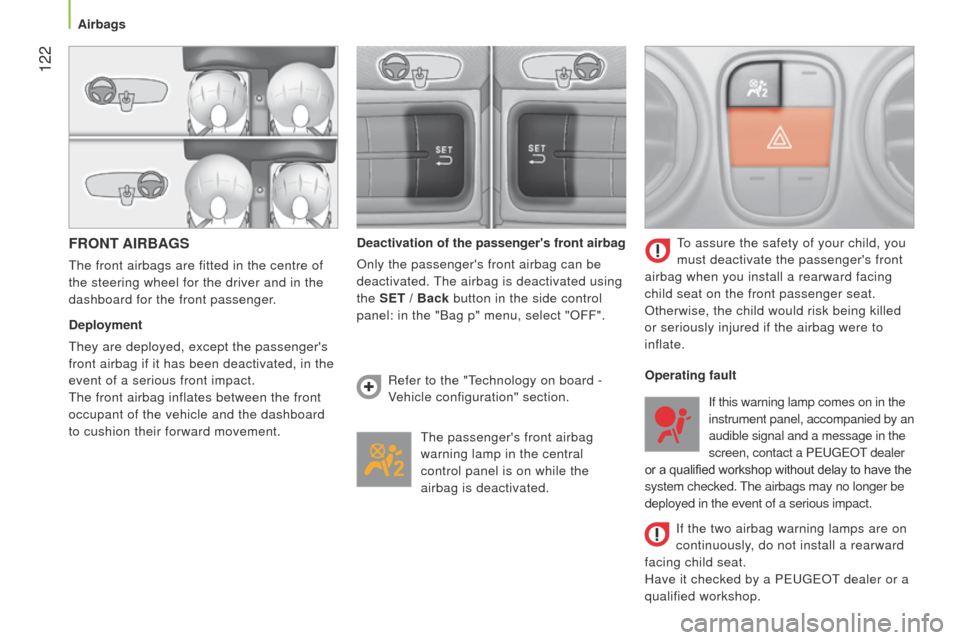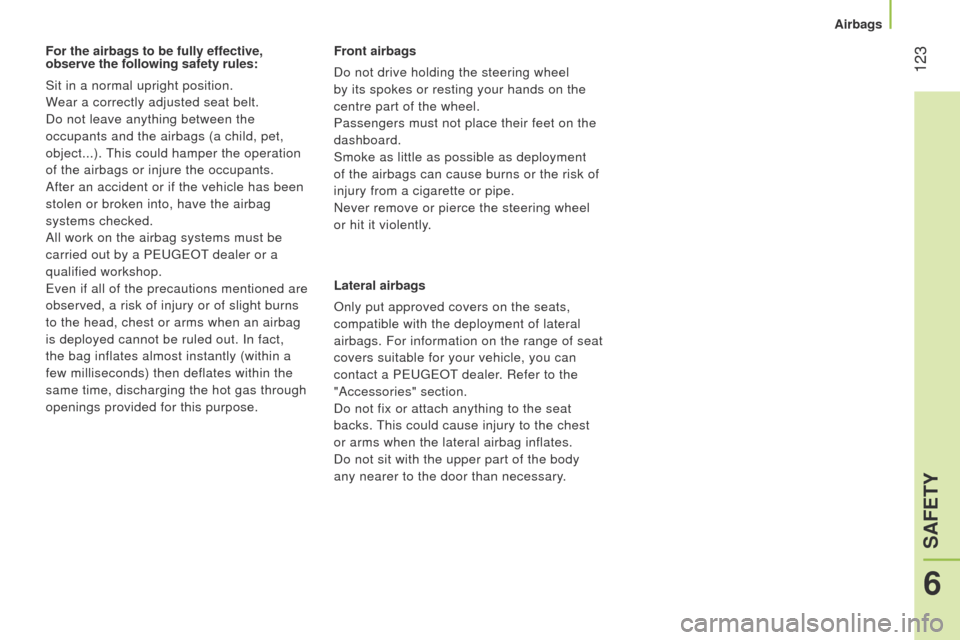Page 124 of 192

122
Bipper_en_Chap06_securite_ed02-2014
FRONT AIRBAGS
the front airbags are fitted in the centre of
the steering wheel for the driver and in the
dashboard for the front passenger.
Deployment
t
hey are deployed, except the passenger's
front airbag if it has been deactivated, in the
event of a serious front impact.
t
he front airbag inflates between the front
occupant of the vehicle and the dashboard
to cushion their forward movement. Deactivation of the passenger's front airbag
Only the passenger's front airbag can be
deactivated. t
he airbag is deactivated using
the SET / Back button in the side control
panel: in the "Bag p" menu, select "OFF".
t
he passenger's front airbag
warning lamp in the central
control panel is on while the
airbag is deactivated.
to assure the safety of your child, you
must deactivate the passenger's front
airbag when you install a rearward facing
child seat on the front passenger seat.
Otherwise, the child would risk being killed
or seriously injured if the airbag were to
inflate.
Refer to the "
t
echnology on board -
Vehicle configuration" section. Operating fault
If the two airbag warning lamps are on
continuously, do not install a rearward
facing child seat.
Have it checked by a P
euge O t
dealer or a
qualified workshop. If this warning lamp comes on in the
instrument panel, accompanied by an
audible signal and a message in the
screen, contact a P
euge O t
dealer
or a qualified workshop without delay to have the
system checked.
t
he airbags may no longer be
deployed in the event of a serious impact.
Airbags
Page 125 of 192

123
Bipper_en_Chap06_securite_ed02-2014
For the airbags to be fully effective,
observe the following safety rules:
Sit in a normal upright position.
Wear a correctly adjusted seat belt.
Do not leave anything between the
occupants and the airbags (a child, pet,
object...).
t
his could hamper the operation
of the airbags or injure the occupants.
After an accident or if the vehicle has been
stolen or broken into, have the airbag
systems checked.
All work on the airbag systems must be
carried out by a P
euge O t
dealer or a
qualified workshop.
e
ven if all of the precautions mentioned are
observed, a risk of injury or of slight burns
to the head, chest or arms when an airbag
is deployed cannot be ruled out. In fact,
the bag inflates almost instantly (within a
few milliseconds) then deflates within the
same time, discharging the hot gas through
openings provided for this purpose. Front airbags
Do not drive holding the steering wheel
by its spokes or resting your hands on the
centre part of the wheel.
Passengers must not place their feet on the
dashboard.
Smoke as little as possible as deployment
of the airbags can cause burns or the risk of
injury from a cigarette or pipe.
Never remove or pierce the steering wheel
or hit it violently.
Lateral airbags
Only put approved covers on the seats,
compatible with the deployment of lateral
airbags. For information on the range of seat
covers suitable for your vehicle, you can
contact a P
euge O t
dealer
. Refer to the
"Accessories" section.
Do not fix or attach anything to the seat
backs.
t
his could cause injury to the chest
or arms when the lateral airbag inflates.
Do not sit with the upper part of the body
any nearer to the door than necessary.
6
SAFETY
Airbags
Page 146 of 192
144
Bipper_en_Chap08_verifications_ed02-2014
OPENING THE BONNET
On the inside
Pull the release lever below the dashboard
towards you.
On the outside
Raise the bonnet slightly, placing your hand
flat under the bonnet to make the operation
easier.
Push the safety catch lever to the left, then
open the bonnet fully.
While holding the bonnet open, check
that the locking control A is engaged by
pressing it.
To close
lift the bonnet slightly and pull the release
control A to release it.
l
ower the bonnet and release it at the end
of its travel. Check that the bonnet is fully
latched.
Avoid opening the bonnet in strong winds.
Before doing anything under the
bonnet, switch off the ignition with the
key to avoid any risk of injury resulting from
an automatic change to S
t
ARt mode. Because of the presence of electrical
equipment under the bonnet, it is
recommended that exposure to water (rain,
washing, ...) be limited.
Opening the bonnet
Page 160 of 192

158
Bipper_en_Chap09_aide-rapide_ed02-2014
TEMPORARY PUNCTURE REPAIR KIT
this kit is located at the front of the
passenger compartment. It consists of:
-
a repair cartridge
A, containing the
sealant, equipped with:
●
a filling
pipe B,
●
a
sticker C
indicating "max. 80 km/h", which
the driver must affix to the dashboard in a
visible position after repairing the tyre,
-
a compressor
D equipped with a pressure
gauge and unions,
-
adaptors for the inflation of various items,
-
a pair of protective gloves,
-
a quick guide to use of the temporary
puncture repair kit.
Repair procedure
- Apply the parking brake and place the
gear lever in neutral.
-
u nscrew the valve cap of the tyre to be
repaired.
-
t
ake out the filling pipe
B and screw the
ring E onto the tyre valve.
-
Check that the on/of
f switch F on the
compressor is in position "0" (off). -
Start the engine.
-
Insert the connector
G
in the nearest
12 V accessory socket in the vehicle.
-
Place the compressor
’s on/off switch F
in
position "1" (on).
-
Inflate the tyre to a pressure of 3 bars.
to obtain a more accurate reading, you are
advised to check the pressure value on the
pressure gauge H , with the compressor off.
t
his temporary puncture repair kit is
available from P euge O t
dealers.
It is provided for the repair of holes of
a maximum diameter of 4 mm, located
exclusively on the tread or side wall of the
tyre. Avoid removing any foreign bodies
which have penetrated into the tyre.
Changing a wheel
Page 169 of 192

167
Bipper_en_Chap09_aide-rapide_ed02-2014
CHANGING A FUSE
the two fuseboxes are placed on the
dashboard on the driver ’s side and under
the bonnet.
Removing and fitting a fuse
Before changing a fuse, the cause of the
fault must be found and rectified.
t
he fuse
numbers are indicated on the fusebox.
Always use the special tweezer to extract
the fuse from its housing and check the
condition of its filament.
Always replace a faulty fuse with a fuse
of the same rating.
If a fuse fails again soon after replacement,
have the electrical system of your vehicle
checked by a P
euge O t
dealer or a
qualified workshop. Access to fuses in the dashboard
-
t
o gain access to the dashboard fuses,
remove the 2 screws using the ignition
key and tilt the housing.
P
euge
O
t
will not accept responsibility
for the cost incurred in repairing your
vehicle or for rectifying the malfunctions
resulting from the installation of accessories
not supplied and not recommended by
P
euge
O
t
dealers and not installed in
accordance with its instructions, in particular
when the combined consumption of all of
the additional equipment connected exceeds
10
milliamperes.
A.
Good.
B.
Failed.
C.
T
weezer.
Access to fuses in the engine
compartment
-
For access to the fuses in the engine
compartment, remove the left hand front
headlamp connector, then unclip the
fusebox cover.
9
QUICK HELP
Changing a fuse
Page 170 of 192
168
Bipper_en_Chap09_aide-rapide_ed02-2014
Table of dashboard fuses, driver’s
sideMarking RatingFunctions
F12 7.5 ARight-hand dipped beam headlamp supply
F13 7.5 A
l
eft-hand dipped beam headlamp supply - headlamp height
adjuster
F31 5 A
e
ngine control unit supply switch
F32 7.5 AFront lamp - front courtesy lamp - rear courtesy light lamp
F36 10 AAudio system - mobile telephone pre-equipment -
air conditioning control panel -
e ODB diagnostic socket
F37 5 ABrake lamp - instrument panel
F38 20 ADoor locking
F43 15 AScreenwash pump
F47 20 ADriver’s electric window motor supply
F48 20 APassenger’s electric window motor supply
F49 5 AParking sensors control unit - rear lighting switch -
electric door mirrors - volumetric alarm
control unit
F50 7.5 AAirbags control unit
F51 7.5 ASwitch on brake pedal - switch on clutch pedal -
door mirror controls - central Bluetooth
system
F53 5 AInstrument panel - rear foglamps
Changing a fuse
Page 185 of 192
183
Bipper_en_Chap10_caracteristique_ed02-2014
IDENTIFICATION MARKINGS
A. Manufacturer's plateB. Serial number on the body
C. Paint code
D. Serial number on the dashboard
E. Tyre pressures
1.
VF type serial number
.
2.
g ross vehicle weight ( g VW).
3.
g ross train weight ( gt W).
4.
Maximum weight on front axle.
5.
Maximum weight on rear axle.
Identification markings
TECHNICAL DATA
10